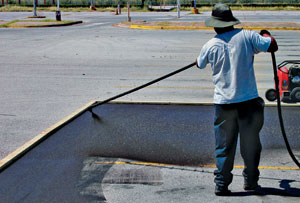Sealing driveways and parking lots with coal tar makes them look uniform and last longer.

For two hours after application, coal tar sealed surfaces emit 30,000 times more toxic chemicals than non-sealed surfaces. Photo: City of Austin
But it could also put cancer causing chemicals in the nearby environment.
Pavement in the Great Lakes region is often coated with coal tar sealants to protect it from the elements. The sealed surfaces put toxic chemicals in air and water long after application, according to a recent study in Environmental Science and Technology.
Researchers from the U.S. Geological Survey’s Texas Water Science Center found that coal tar sealed surfaces are a major source of polycyclic aromatic hydrocarbon (PAH) compounds. Not all PAH compounds are the same, but some are highly carcinogenic and some have been linked to problems in children, like low IQ scores, asthma and premature births.
The chemicals are also toxic to wildlife.
There are two kinds of sealant — asphalt and coal tar. Coal tar, a by-product of making coal gas, has about 1,000 times more PAHs than asphalt. Great Lakes states mostly use the coal tar.
The chemicals are released into the air when applied. But, once the sealant dries, it can also rub off from tires creating dust, which can run off into ponds, rivers and lakes, or blow into soils and be tracked into homes.
“These products (coal tar sealants) appear to be a major source of PAHs in every direction going away from the parking lot,” said Peter Van Metre, a U.S. Geological Survey research hydrologist and study co-author.
PAHs occur naturally in oil, coal and tar and have been on the rise in the environment, but for years “no one in the research community connected the dots,” linking the increasing chemicals to coal tar sealants, Van Metre said.
A 2010 U.S. Geological Survey study tested forty urban lakes for PAHs, eight of them in Great Lakes states, and found the coal tar sealants were the largest source of the chemicals in the lakes’ sediment, contributing about one half.
Some counties in Great Lakes states have taken action. Thirteen Minnesota counties, Dane County, Wisc., and Suffolk County, N.Y., have coal tar sealant bans.
Dane County officials banned them after seeing previous studies and after local stormwater monitoring suggested that coal tar sealants were a growing concern, said Sue Jones, watershed management coordinator with Dane County.
She said since there are coal tar sealant alternatives, there wasn’t much backlash from the 2007 ban. Coal tar sealants are usually a bit more expensive than asphalt, according to the Pavement Coatings Technology Council.
Minnesota had a bigger problem. Stormwater ponds around Minneapolis and St. Paul had so many PAHs in their sediment that the dredged gunk had to be taken to a landfill, costing cities big bucks, Van Metre said.
In 2009, state agencies were banned from using coal tar sealants. But the counties that have bans did that on their own after looking at stormwater cleanup costs, said Don Berger, a state program administrator of storm-water policy for the Minnesota Pollution Control Agency.
Berger said it is too early to tell if the bans have decreased chemicals in stormwater ponds.
But for those communities without bans, coal tar sealants are common. For example, the study found that 90 percent of driveways in the Lake in the Hills watershed in northwest Illinois were coal tar sealed.
And while unsealed pavement emits PAHs too, from things like motor oil and tar, the differences are staggering. For two hours after application, PAHs are emitted from freshly coated surfaces 30,000 times greater than unsealed pavement.
Coal tar sealed surfaces still emit 60 times more PAHs than unsealed pavement years after the application.
The chemicals can be inhaled or absorbed through the skin. They settle into sediment so they’re not a major threat to drinking water, but aquatic bottom dwellers are at a high risk. The chemicals cause problems like fin erosion, liver damage, cataracts and skin tumors in fish, according to the EPA.
While overlooked for years by researchers, coal tar sealants are a potent polluter.
“Just the initial application and drying of seal coat each year exceeds PAH emissions of all the vehicles on the road,” Van Metre said. “Now that’s something.”
Dear Rufour,
What’s pretty amazing is that you would expect anyone to believe your statement about Denorex and a pork chop! i have used denorex and eaten many a pork chop. I have also sealed an acre of asphalt with coal tar. Only one of these activities has made me sick and severly burned my skin from the rising vapors. I’ll let you guess which one. Trust me on this coal tar pavement sealer is nasty stuff.
What’s pretty amazing is that the PAH load of 1 acre of Applied Refined Coal Tar Sealcoat = 2oz of Denorex Shampoo or BBQ’ing a 6 oz Pork Chop.
Before this charade continues – Would greatly appreciate Someone, With Some Authority over the USGS to Show Testing Results that the Ban in Austin, Actually Reduced the PAH’s.
Amazing that the Only Competing/Advocated Product is Asphalt (OIL) Based. Which (OMG-Can it Be?) happens to be The #1 Industry in TEXAS – OIL.
Surprise, Surprise, Surprise,-
An Elected Texas Official with The Backing of The USGS-Texas (Which is Not Suppose to Advocate on Commerce), put forth this Bill.
Either – Follow the Facts, or Follow the Money! Math is Needed for Both – The USGS manipulated the Math for Supposed Science….
While the Math for the Oil Industry Increases our Need on Foreign Oil!!
Really – “Cancer Time Bomb” –
So much for Responsible Science!!
Anything to do with non-renewables is harmful to critters and human beings.
Pingback: Coal tar sealant linked to toxic chemicals in water, air « Environmental News Bits